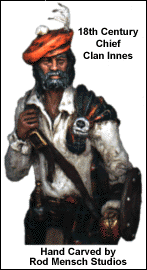
|
Part Two: 1785-1813 Slowly, change crept into the system; many Clan Chiefs leased their holdings to others or sold their lands outright and left for the cities and the lifestyle of the rich. Others found that they could lease their land to people who would pay much more than the Scots could afford. Thus a process of eviction started, gradually at first, which built to a floodtide of immigration later.
This first wave of immigration of the Highlanders that occurred from around 1770 to 1790 was not physically forced. It was simply a displacement of the people of the old system with those who worked the land to make money and therefore could pay higher rents. Many of these Scots considered the lands that they had lived on their own, as they and their ancestors had fought and died to maintain that land. But this was not the case, as they were sold out for others who could pay a higher price. This initial wave consisted of over seven thousand Scots who left their homes for the colonies and greener pastures. Some of these people sold their lands and left with cash, in a process that was draining Britain of its money. Although they did not realize it, these first immigrants were the lucky ones.
Some Scotsmen managed to hold their lands through this new means although the old tenants were forced to leave. Many of these people scratched out a living by fishing and collecting kelp. This was a hard life and some died in the attempt.
The floodgates were now open, and many moved into the Highlands from England and lowland Scotland buying the land outright. The tenants who had lived on the lands for years were forcibly evicted when they resisted the move by the law. Many of these had their homes burned, were arrested and sent to the colonies as indentured slaves without their possessions. This sudden popularity, along with the introduction of the Cheviot strain of sheep in 1790, changed the whole view of the previously barren and undesirable lands of Scotland.
There are many examples of the forceful Clearances of this time. They started in Glengarry around 1785, which was followed by other notable Clearances of Strathglass and Sutherland. There were others of course of less consequence, but the Strathglass Clearance alone was responsible for the displacement of two thousand Scottish families a day during its peak. It was during the Sutherland Clearances of 1813, that the first signs of real trouble began to rear its ugly head.
It was reported that the Gunn Clan refused to leave their lands: in actuality they were only grumbling. But the rumor spread like wildfire among the new English populace that the Highlanders were rising in revolt. In response, an armed force was sent to stop any such effort at rebellion. The incident ended peaceably, but it was only a harbinger of events that were soon to take place in Scotland.
by BW, March 2000
Back to Highland Clearances Main Page
Highland Clearances Part Two
Highland Clearances Part Three
Links:
The Acts Against Highland Dress
|
Thursday, December 26th, 2019
Attention visitors: Tartans.com is back. Please note that this is a snapshot of the site as it existed nearly 20 years ago and you may encounter broken links; we are still combing through the site and correcting those as we find them. Please also note that some sections are currently not functional, primarily the discussion forums/clan chat boards.
|
** HOME - First Time Visitors - Glossary - - Contact Us ** Awards | Bibliography | Clan Calendar | Clan Chat | Clan Finder | History | Famous Scots | Genealogy | Great Hall of the Clans | Links | News and Features | Scots on the Net | Search | Site Map The Gathering of the Clans
Copyright 1995- Tartans.com - All Rights Reserved. |
 As mentioned in
As mentioned in 

